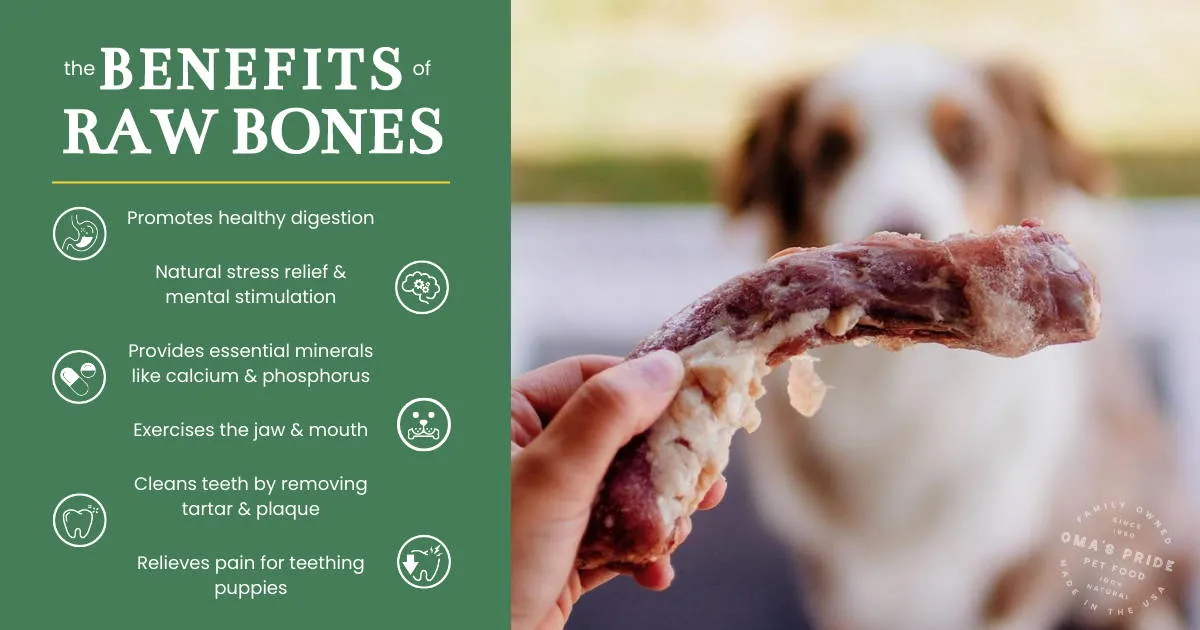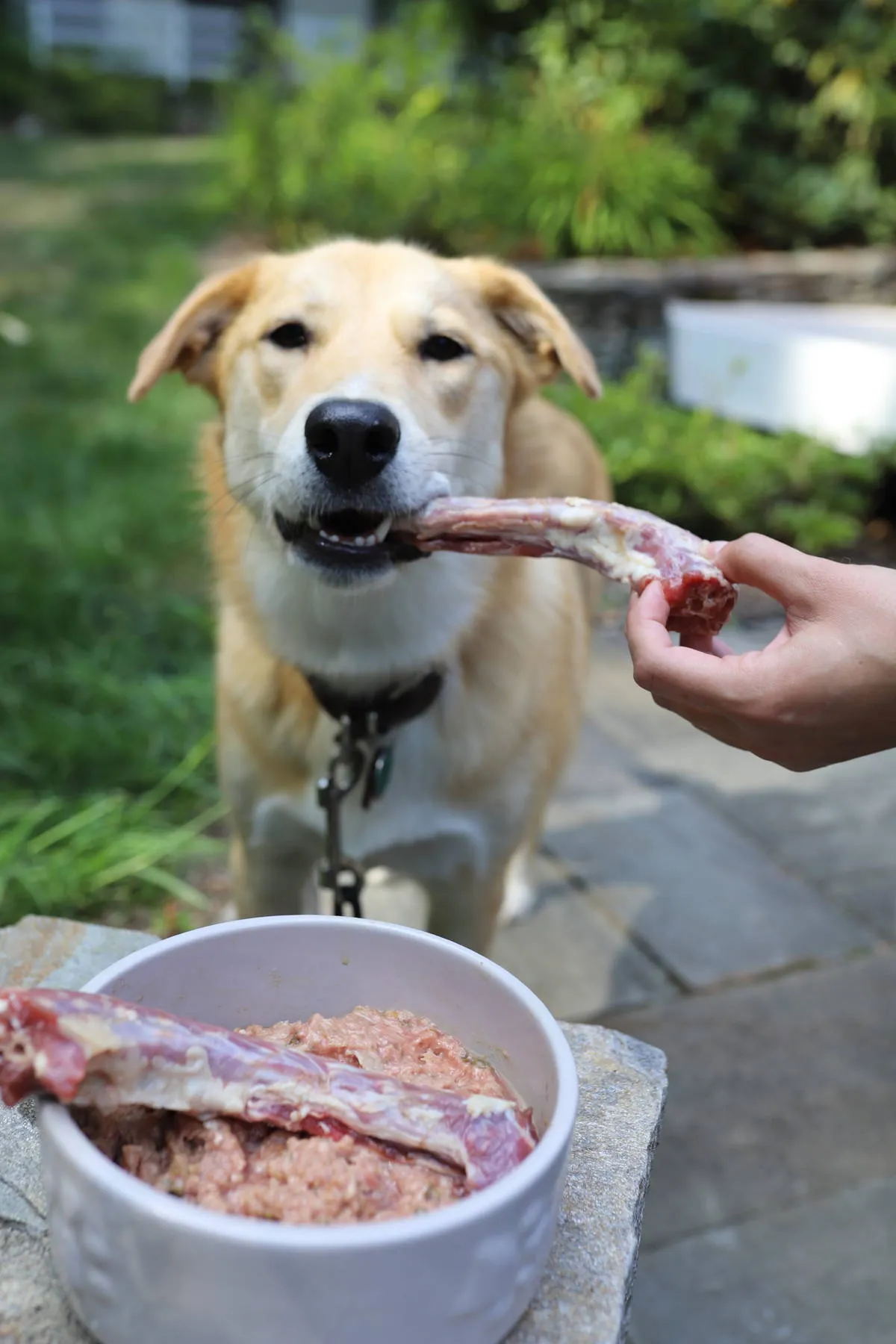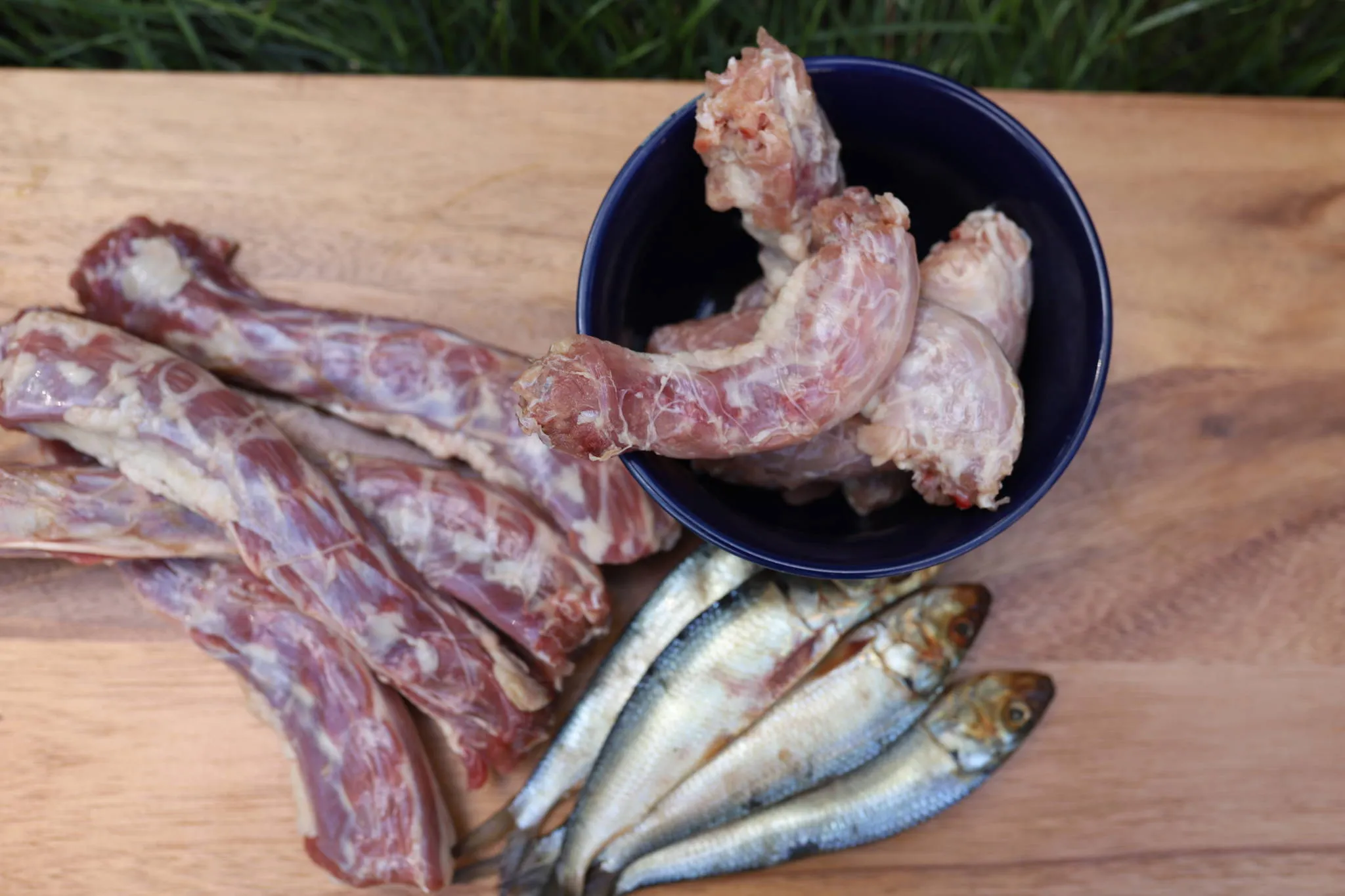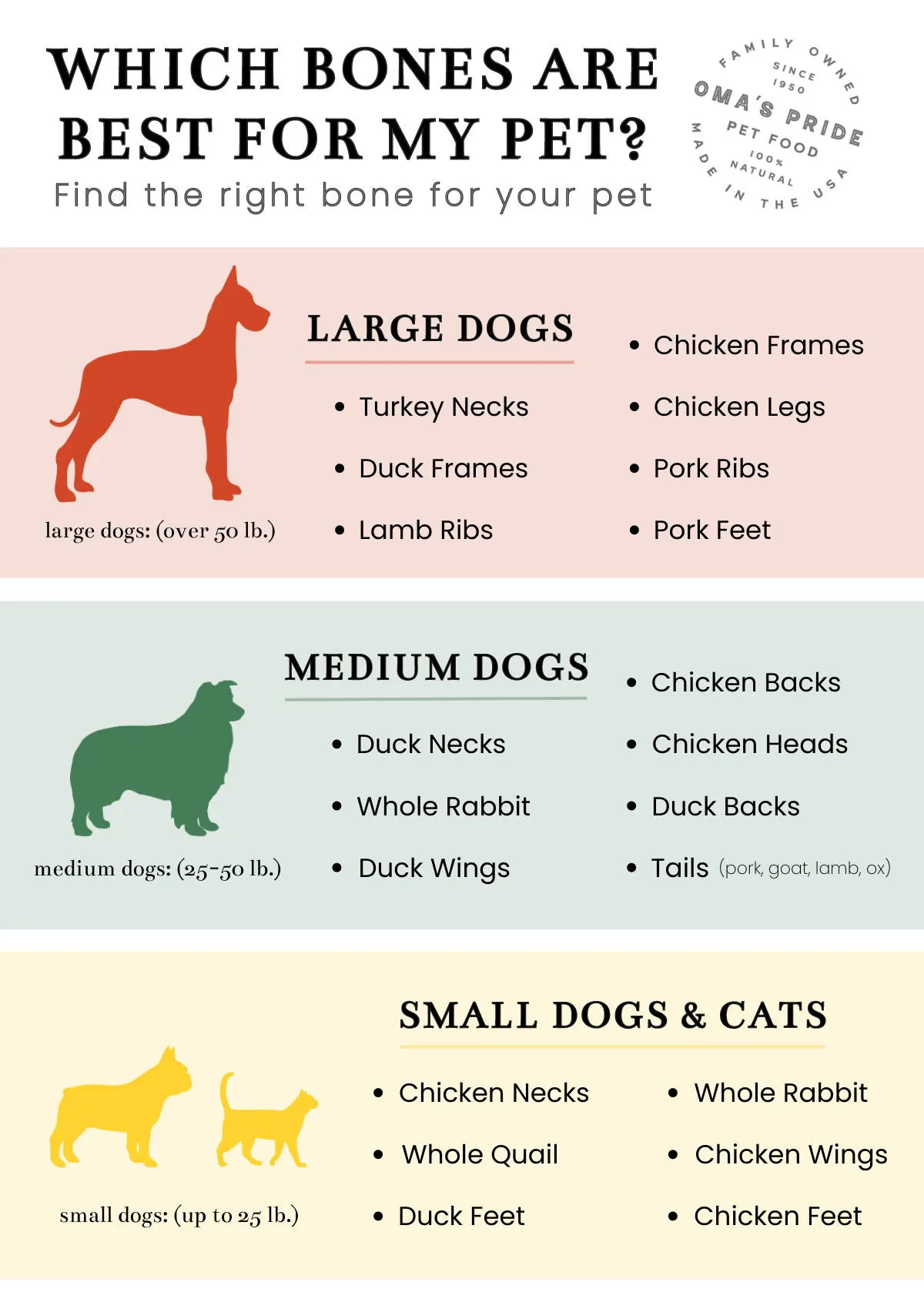The image of a dog happily gnawing on a bone is as timeless as it is natural. For centuries, bones have been an integral part of a canine’s diet, offering far more than just a chew toy. In the world of modern pet care, however, understanding What Bones Can Dogs Eat Raw is crucial for ensuring their safety and maximizing health benefits. This guide, brought to you by Dog Care Story, will delve into the essential role raw bones play in canine well-being, distinguishing between different types, outlining their benefits, and providing vital safety precautions to help you make informed decisions for your furry companion.
Feeding raw bones supports healthy digestion, cleans teeth, provides mental stimulation, strengthens jaw and mouth muscles, eases anxiety, and delivers essential nutrients like calcium and phosphorus. Generally, raw bones can constitute about 10-15% of your dog’s overall diet, with recreational bones offered 1-2 times per week. Understanding the nuances of raw bone feeding is key to unlocking these benefits safely and effectively for your dog. For a broader understanding of canine nutrition, consider exploring what foods dogs can and cannot eat.
Understanding Raw Bones for Dogs: Edible vs. Recreational
When considering what bones can dogs eat raw, it’s important to recognize that not all bones are created equal. Raw bones fall into two primary categories, each serving distinct purposes for your dog’s health and enrichment.
Edible Bones (Raw Meaty Bones – RMBs)
Edible bones, often referred to as Raw Meaty Bones (RMBs), are raw, uncooked pieces of meat, bone, tissue, and cartilage that dogs are meant to consume whole. These bones are soft, hollow, and pliable enough to be fully digested. They are typically sourced from smaller animals or non-weight-bearing parts of larger animals, such as chicken, quail, duck, rabbit, turkey, or pork. RMBs are a cornerstone of a balanced raw diet, providing crucial nutrients like phosphorus, calcium, and other vital minerals necessary for strong bones, teeth, and overall organ function.
Recreational Bones
Recreational bones are raw, uncooked bones primarily intended for chewing, not for full consumption. These are typically larger and harder, often filled with marrow and covered in a small amount of meat and tissue. They come from larger, more robust parts of animals such as bison, cow, elk, moose, deer, or buffalo, focusing on areas like the knuckle, femur, shank, rib, tibia, or hip. While they offer excellent mental stimulation and dental cleaning, recreational bones are not meant to be a significant dietary source of nutrients and should be treated more like a treat or supplement.
The Diverse Benefits of Raw Bones for Your Dog
The benefits of incorporating raw bones into your dog’s routine extend beyond simple nutrition, encompassing dental health, mental well-being, and physical strength.
Nutritional Benefits of Edible Bones
Edible raw bones are a powerhouse of essential nutrients, directly contributing to your dog’s internal health. They are rich in calcium and phosphorus, minerals crucial for maintaining strong teeth and bones, as well as supporting vital organ and tissue function throughout the body. The fibrous tissues in edible bones also aid in healthy digestion, binding to food in the digestive tract to promote regular bowel movements and prevent loose stools. Beyond minerals, RMBs also supply protein, iron, collagen, essential fatty acids, and a spectrum of vitamins and amino acids.
 List of 6 benefits of bones next to dog behind a chicken neck.
List of 6 benefits of bones next to dog behind a chicken neck.
Comprehensive Benefits of All Raw Bones
Beyond the specific nutritional contributions of edible bones, both edible and recreational raw bones offer a range of universal benefits that significantly enhance a dog’s quality of life.
- Natural Instinct Fulfillment: Dogs are carnivores with an innate desire to chew. Gnawing on bones provides crucial mental stimulation, acting as a natural release that helps satisfy this instinct. The challenge of ripping and tearing releases endorphins, keeping your dog engaged and reducing boredom-induced destructive chewing on household items.
- Oral Health and Hygiene: Perhaps one of the most recognized benefits, chewing on raw bones is the most natural and effective way to clean your dog’s teeth. The abrasive action helps to scrape away plaque and tartar buildup, preventing gum disease and maintaining clean teeth and healthy gums.
- Strengthens Jaw and Mouth Muscles: Regular chewing sessions on both types of raw bones provide an excellent workout for your dog’s jaw, mouth, neck, and shoulder muscles, contributing to overall physical strength and well-being.
- Relieves Teething Pain in Puppies: For puppies experiencing the discomfort of teething, a raw bone can be a soothing chew object. It helps alleviate pain and anxiety as their adult teeth emerge, redirecting their chewing instincts to appropriate items.
- Safe Alternative to Rawhide: Many pet owners are aware of the potential dangers associated with rawhide chews, which can be difficult to digest, made with harsh chemicals, and pose choking or blockage hazards. Raw meaty bones and recreational bones offer a natural, safer, and more beneficial alternative for entertaining dogs and promoting dental health. To learn more about other potentially harmful items, you might want to review list of what foods dogs should not eat.
Diving Deeper: Understanding Edible Raw Bones
As you consider what bones can dogs eat raw for their dietary needs, edible raw bones are paramount. These softer, more hollow bones, often covered in meaty tissue and cartilage, are designed to be fully consumed and digested. Poultry bones are frequently favored by raw feeders due to their smaller size and softer nature. However, it’s essential to remember that not all bones, even from poultry, are suitable to eat raw and whole. Larger, weight-bearing bones are more likely to splinter and should generally be avoided as RMBs.
 Yellow puppy with raw bone in mouth behind bowl of raw food.
Yellow puppy with raw bone in mouth behind bowl of raw food.
Getting Started with Edible Bones
If you’re introducing your dog to a raw diet or edible bones for the first time, a gradual approach is key. It’s recommended to wait 7-10 days after transitioning from kibble before introducing RMBs. While raw meaty bones are excellent for many dogs, they aren’t suitable for all. Dogs with weakened enamel, pre-existing dental issues, overly aggressive chewers, or those with no desire to chew may not thrive with RMBs. In such cases, alternatives should be considered.
When starting, begin with smaller, softer pieces like a duck foot, gradually increasing the size as your dog adapts to match their chewing ability and size. Always thaw bones thoroughly in the refrigerator for 24 hours before serving. Provide an appropriate, easily cleanable space for your dog to chew, such as outdoors or on a towel, to manage any mess.
 Raw chicken necks, turkey necks, and whole sardines on top of a wooden board.
Raw chicken necks, turkey necks, and whole sardines on top of a wooden board.
Calculating Bone Percentage
When raw feeding, it’s crucial to ensure your dog receives the correct amount of bone content to balance phosphorus and calcium effectively (aiming for approximately a 1:1 ratio). A general rule of thumb is that bones should constitute about 10-15% of your dog’s total raw diet. The bone content varies significantly between different types of edible bones; for instance, a turkey neck might contain around 45% bone, while a chicken foot could be closer to 60%. Monitoring your dog’s stool is vital for adjusting bone content; hard, chalky, or white stools indicate too much bone, while loose stools may suggest too little.
Alternatives to Whole Raw Meaty Bones
For dogs unable to consume whole raw meaty bones, several excellent alternatives can still provide essential nutrients and benefits. Green tripe, for example, offers a naturally balanced calcium and phosphorus ratio similar to RMBs. Food-grade bone meal (preferably unheated), seaweed, or coral calcium supplements can also be used, though careful balancing of calcium and phosphorus levels is essential. Another convenient option is purchasing raw mixes that already include ground bone, allowing your dog to receive the benefits without needing to chew whole bones.
Appropriate Edible Bones Based on Pet Size
Choosing the right size and type of edible bone is paramount for safety and effectiveness.
- Necks: Chicken necks are suitable for dogs and cats of all sizes. Duck necks are better for medium-sized dogs, while turkey necks are ideal for larger breeds.
- Whole Small Animals/Fish: Whole sardines, mackerel, and quail are appropriate for all sizes of dogs and cats.
- Wings: Chicken wingettes, wing tips, and drumettes are safe for all sizes. Duck wings suit medium-sized dogs and up, while turkey wings are best for large dogs (removing the dense drumette first is recommended).
- Feet: Chicken and duck feet are excellent for all pets due due to their rich tissue and ligament content. Pork feet are more appropriate for large dogs but should be fed in moderation due to their high fat content.
- Frames: Chicken and duck frames can be fed to pets of all sizes.
- Tails: Larger tails from pigs, turkeys, goats, lambs, or oxen are best for medium-sized dogs and up. Smaller tails may be suitable for smaller pets.
- Ribs: Lamb or pork ribs should generally be reserved for large dogs.
 Graphic showing what raw meaty bones are appropriate for dogs based on size (large, medium, and small).
Graphic showing what raw meaty bones are appropriate for dogs based on size (large, medium, and small).
Diving Deeper: Understanding Recreational Raw Bones
Beyond edible bones, recreational raw bones play a significant role in a dog’s life, primarily for chewing pleasure and dental health rather than nutritional intake. These bones are larger and harder than edible bones and are not meant to be eaten whole. It’s crucial to select the correct size to prevent your dog from hurting themselves or attempting to swallow the bone. For instance, large marrow and knuckle bones are suitable for medium to large dogs, while smaller rib bones might be appropriate for smaller animals. Remember, recreational bones cannot replace the calcium and phosphorus provided by edible bones or bone meal in a balanced diet; they should be considered a treat. For more details on what your specific breed can or cannot eat, such as what can t german shepherds eat, further research is always beneficial.
Types of Recreational Bones
Recreational bones are typically sourced from large, weight-bearing parts of robust animals like cows, buffalo, bison, elk, deer, or moose. Common cuts include the femur, tibia, shank, or hip areas, chosen for their durability and size, which withstand prolonged chewing sessions.
How to Safely Feed Recreational Bones
Feeding recreational bones safely ensures your dog gets the most out of this enriching activity without risk. You can give your dog a raw bone directly from the freezer or allow it to thaw slightly, especially for less aggressive chewers. It’s generally best to limit chewing sessions for raw beef marrow bones to about 20 minutes, 1-2 times per week, as the marrow is fatty and can cause digestive upset if consumed too frequently.
Here are some essential tips for a safe and positive experience:
- Choose the Right Setting: Raw bones can be messy. Provide them in an ideal location, such as outdoors, on a washable towel, or another easily sanitizable surface. Avoid distractions or new environments that might trigger resource-guarding behaviors when other dogs or people are present.
- Teach “Drop It”: It’s imperative that your dog knows the “drop it” command. This allows you to safely intervene if the bone becomes a choking hazard or if you need to remove it for any other safety reason.
- Feed After a Meal: Offering a recreational bone after your dog has eaten a full meal can prevent overly aggressive chewing or overindulgence, as they will be less hungry.
- Exercise Alternative: On days when outdoor exercise isn’t feasible due to extreme weather or other circumstances, a recreational bone can serve as an excellent alternative, keeping your dog occupied and mentally stimulated.
- Follow Safe Food Handling: Always wash your hands thoroughly after handling raw bones. Sanitize all surfaces the bone has touched, and store any unfinished bones in the refrigerator or freezer until the next feeding session to prevent bacterial growth.
Crucial Safety Precautions When Feeding Raw Bones
While feeding raw bones to dogs is generally safe and highly beneficial, it’s essential to be proactive and understand the associated risks. Your dog’s chewing habits, temperament, and overall health dictate what they can safely handle. Begin slowly with smaller, softer pieces and gradually increase the size as your dog becomes more accustomed and you feel comfortable with their chewing behavior.
Though rare, choking, splintering, and intestinal blockages can occur with raw bones. Therefore, constant supervision while your dog chews is non-negotiable, allowing you to intervene quickly if a problem arises.
Important Safety Tip: Never feed cooked, smoked, roasted, boiled, or any other heat-processed bones. Heating bones removes their moisture, making them hard, brittle, and highly prone to splintering into dangerous sharp fragments that can severely injure your dog’s teeth, mouth, throat, or internal organs. For a comprehensive overview of a raw diet, you may find what can dogs eat on a raw diet to be very helpful.
Where to Purchase Safe Raw Bones for Your Dog
Now that you understand what bones can dogs eat raw and the necessary precautions, you might be wondering where to source these beneficial chews. The best places to purchase raw bones for canine consumption are typically online pet retailers specializing in raw pet food, local farmer’s markets, raw co-ops, or reputable butchers.
When buying from a butcher, ensure they are aware that the bones are for canine consumption, as standard machine-cut bones not prepared for raw eating may have sharp, dangerous edges. It’s generally not recommended to feed dogs raw bones or meat from conventional grocery stores. These meats are usually stored at refrigerated temperatures that can foster bacterial growth and are intended for full cooking before human consumption, not for raw feeding to pets.
Frequently Asked Questions About Raw Bones
Can dogs eat bones?
Yes, most dogs can safely eat both whole raw meaty bones (edible bones) and recreational bones as part of a balanced diet. However, whole bones may not be ideal for all dogs, particularly those with overly aggressive chewing habits or pre-existing dental problems.
Are raw bones safe for dogs?
Raw bones are safe for dogs when appropriate types and sizes are selected, dogs are closely monitored during chewing sessions, and the bones are sourced from trusted pet retailers, local raw co-ops, or butchers who understand safe preparation for canine consumption.
